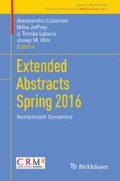Abstract
Sleep-wake regulation is an example of a system with multiple timescales, with switching between sleep and wake states occurring in minutes but the states of wake or sleep usually existing for some hours. Here, we discuss some general features of models of sleep-wake regulation. We show that some typical models of sleep-wake regulation can be reduced to one-dimensional maps with discontinuities, and show that this reduction is useful in understanding some of the dynamical behaviour seen in sleep-wake models.
Access this chapter
Tax calculation will be finalised at checkout
Purchases are for personal use only
References
S.N. Archer, E.E. Laing, C.S. Möller-Levet, D.R. van der Veen, G. Bucca, A.S. Lazar, N. Santhi, A. Slak, R. Kabiljo, M. von Schantz, C.P. Smith, D.J. Dijk, Mistimed sleep disrupts circadian regulation of the human transcriptome. Proc. Natl. Acad. Sci. 111, E682–E691 (2014)
F.P. Cappuccio, L. D’Elia, P. Strazzullo, M.A. Miller, Sleep duration and all-cause mortality: a systematic review and meta-analysis of prospective studies. Sleep 33, 585–592 (2010)
S. Daan, D.G.M. Beersma, A.A. Borbély, Timing of human sleep: recovery process gated by a circadian pacemaker. Am. J. Physiol. 246, R161–R178 (1984)
A. Granados, L. Alsedà, M. Krupa, The period adding and incrementing bifurcations: from rotation theory to applications. Preprint, arXiv:1407.1895
C.S. Möller-Levet, S.N. Archer, G. Bucca, E. Laing, A. Slak, R. Kabiljo, J. Lo, N. Santhi, M. von Schantz, C.P. Smitth, D.J. Dijk, Effects of insufficient sleep on circadian rhythmicity and expression amplitude of the human blood transcriptome. Proc. Natl. Acad. Sci. 110, E1132–E1141 (2013)
M. Nakao, M. Yamamoto, Bifurcation properties of the two process model. Psychiatry Clin. Neurosci. 52, 131–133 (1998)
A.C. Skeldon, D.J. Dijk, G. Derks, Mathematical models for sleep-wake dynamics: comparison of the two-process model and a mutual inhibition neuronal model. PLoS ONE 10, e103877 (2014)
Acknowledgements
The authors thank the Centre de Recerca Matemàtica for the opportunity to work with each other and other participants of the intensive programme on Advances in Nonsmooth Dynamics. ACS and GD are indebted to Prof. Derk-Jan Dijk of the Surrey Sleep Research Centre at the University of Surrey for introducing them to the area of mathematical modelling of sleep-wake regulation.
Author information
Authors and Affiliations
Corresponding author
Editor information
Editors and Affiliations
Rights and permissions
Copyright information
© 2017 Springer International Publishing AG
About this paper
Cite this paper
Skeldon, A.C., Derks, G. (2017). Nonsmooth Maps and the Fast-Slow Dynamics of Sleep-Wake Regulation: Part I. In: Colombo, A., Jeffrey, M., Lázaro, J., Olm, J. (eds) Extended Abstracts Spring 2016. Trends in Mathematics(), vol 8. Birkhäuser, Cham. https://doi.org/10.1007/978-3-319-55642-0_30
Download citation
DOI: https://doi.org/10.1007/978-3-319-55642-0_30
Published:
Publisher Name: Birkhäuser, Cham
Print ISBN: 978-3-319-55641-3
Online ISBN: 978-3-319-55642-0
eBook Packages: Mathematics and StatisticsMathematics and Statistics (R0)

